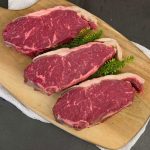 Henry VIII, James I, and Charles II have all been credited at various times with drawing a sword in the midst of a meal in order to dub a particularly tasty cut of beef Sir Loin; the king’s joke—whichever king it was—supposedly sent such a titter round the room that soon all England was clamouring for sirloin. This three-hundred-year-old etymology of sirloin is as untrue as the claim that Sir Lancelot received his name because he liked his lance a lot. In actual fact, sirloin was derived in the mid sixteenth century from the Old French surloigne, the sur part of the word being a preposition meaning above; the sirloin, therefore, is literally the cut of meat above the loin. So established was the false etymology of sirloin, however, that it inspired someone in the mid eighteenth century to give the name Baron of Beef to two sirloins roasted together instead of being cut asunder. Even the French adopted the English title of Baron as their name for this cut of meat; however, in 1953 the Academic Franchise, a government agency whose mandate is to keep French unsullied by foreign borrowings, attempted to replace the English-derived baron with the French bas-rond. Restaurateurs protested, and baron remained.
Henry VIII, James I, and Charles II have all been credited at various times with drawing a sword in the midst of a meal in order to dub a particularly tasty cut of beef Sir Loin; the king’s joke—whichever king it was—supposedly sent such a titter round the room that soon all England was clamouring for sirloin. This three-hundred-year-old etymology of sirloin is as untrue as the claim that Sir Lancelot received his name because he liked his lance a lot. In actual fact, sirloin was derived in the mid sixteenth century from the Old French surloigne, the sur part of the word being a preposition meaning above; the sirloin, therefore, is literally the cut of meat above the loin. So established was the false etymology of sirloin, however, that it inspired someone in the mid eighteenth century to give the name Baron of Beef to two sirloins roasted together instead of being cut asunder. Even the French adopted the English title of Baron as their name for this cut of meat; however, in 1953 the Academic Franchise, a government agency whose mandate is to keep French unsullied by foreign borrowings, attempted to replace the English-derived baron with the French bas-rond. Restaurateurs protested, and baron remained.
Referring to the anterior section of the beef’s loins, encompassing the meat located both above and below the bone.
A retail cut of meat that encompasses the hip bone is known as the “hip cut.” Within this cut, two bones are typically found: the hip bone and the back bone, although the latter is often removed. The appearance of the bones in sirloin steaks and chops varies depending on the specific location of the cut on the hip bone. Progressing from the front to the back of the hip, these bones are referred to as the pin bone, flat bone (widest part of the hip), round bone, and wedge bone (closest to the leg).
